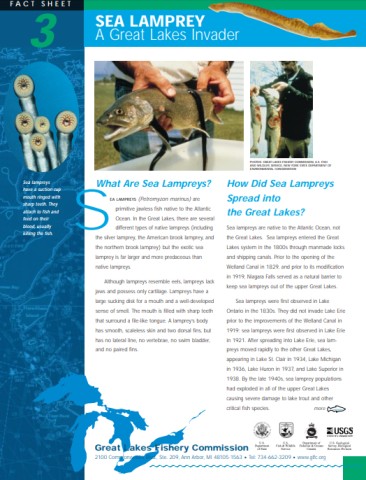Sea Lamprey (Petromyzon marinus)
French common name: Lamproie de mer

Sharp teeth radiate around a rasp-like tongue at the centre of a large sucker mouth.

Sea lamprey in a tank.
Photo by Joanna Gilkeson/USFWS

Sea lampreys are among the oldest invaders of the Great Lakes.
Photo by C. Krueger, GLFC
Order: Lamprey
Family: Petromyzontidae
Did you know? Only one in seven fish attacked by sea lamprey survive.
The Sea Lamprey is a primitive, eel-like fish that invaded the Great Lakes in the early 20th century through shipping canals. In their native range of the northern Atlantic Ocean and the Baltic, western Mediterranean and Adriatic seas, they live part of their lives in salt water, but they have adapted to living entirely in fresh water in their invaded range of the Great Lakes. As adults, they spawn in rivers and streams and their larvae live on organic matter in stream bottoms until they transform into parasites that migrate into lakes. Their mouth is a large sucker with rings of sharp teeth and a raspy tongue that is used to latch onto the side of a fish and feed on its blood. Adults spend 12 to 20 months feeding on the blood of other lake-dwelling fish, until they are ready to travel upstream to spawn, and die shortly after. The complete life cycle usually lasts five to nine years. Sea Lamprey have significantly reduced the number of sportfish in the Great Lakes, as only one in seven fish survive an attack.
How to Identify Sea Lamprey (from the Ontario fact sheet)
Adults
- Cylindrical bodies are 30-76 cm long with no scales
- Leathery skin is grey to dark brown with dark blotches and a lighter belly
- Sharp teeth radiate around a rasp-like tongue at the centre of a large sucker mouth
- The fish has large eyes, two dorsal fins, no pelvic or pectoral fins, a single, mid-dorsal nostril, and seven obvious gill openings on each side
Larvae
- Larvae are up to 18 cm long, blind, and wormlike, with a black to pale grey body and a light underside
- In larvae that are 4 cm or longer, the first and second dorsal fins are distinctly separate

The native range of the sea lamprey includes the Atlantic coast of North America from Newfoundland to northern Florida, the Atlantic coast of Europe, and the Baltic, western Mediterranean, and Adriatic seas. Today, sea lamprey are also found in all of the Great Lakes. Sea lamprey larvae live in Great Lakes tributaries that have suitable habitat until they become juveniles or “transformers.”
According to the Great Lakes Fishery Commission, sea lamprey predation on valuable fish stocks was so high in the 1940s it became a key factor in the collapse of the Great Lakes ecosystem and economy that it supported. Tens of thousands of jobs were lost, property values were diminished, and a way of life was forever changed for millions of people. Sea lampreys killed more than 100 million pounds of Great Lakes fish annually, five times the commercial harvest in the upper Great Lakes.
The devastating impact of sea lamprey on Great Lakes sport, commercial, and Indigenous fisheries in the 1940s and 50s led Canada and the United States to form the Great Lakes Fishery Commission in 1955. Since then, the commission has led a program to assess and control the species using measures that target different stages of its life cycle. Control measures include chemicals that selectively kill lamprey larvae and barriers and traps that prevent adult lampreys from moving upstream to spawn. Although it is likely impossible to eliminate sea lamprey from the Great Lakes, ongoing efforts to control the species have reduced populations by 90%. Unfortunately, the remaining sea lamprey continue to affect native fish species.
- Sea lamprey use their sucker mouth, sharp teeth, and rasping tongue to attach to the body of a fish and suck the fish’s blood. Fish that survive the attack are left with a large open wound that can become infected and often leads to death.
- During its parasitic phase, one sea lamprey can destroy an average of 18 kg of fish.
- As few as one in seven fish may survive a sea lamprey attack. Attacks have resulted in reduced stocks of lake trout, salmon, whitefish, cisco, and burbot in the Great Lakes.
Learn how to identify and prevent the spread of this unwanted species.
- Don’t release any live fish into Canadian waters.
- Don’t help sea lampreys pass over dams and culverts that block their spawning migration.
- If you catch a fish with a sea lamprey attached, do not return it to the water. Kill it and put it in the garbage.
- For questions, contact the Sea Lamprey Control Centre of Fisheries and Oceans Canada at 1-800-553-9091.
- Report other invasive species sightings to the Invading Species Hotline at 1-800-563-7711, or visit www.invadingspecies.com to report a sighting.
Fact Sheets
Best Management Practices

Lorem ipsum dolor sit amet, consectetur adipiscing elit. Ut elit tellus, luctus nec ullamcorper mattis, pulvinar dapibus leo.
Research
Potential for carbon dioxide to act as a non-physical barrier for invasive sea lamprey movement
Evaluating the growth potential of sea lampreys (Petromyzon marinus) feeding on siscowet lake trout (Salvelinus namaycush) in Lake Superior
[PDF] Sea lamprey control: past, present, and future
Current Projects
Lorem ipsum dolor sit amet, consectetur adipiscing elit. Ut elit tellus, luctus nec ullamcorper mattis, pulvinar dapibus leo.
Further Reading
The Invasive Species Centre aims to connect stakeholders. The following information below link to resources that have been created by external organizations.


